2005 RENAULT MEGANE check engine
[x] Cancel search: check enginePage 183 of 250
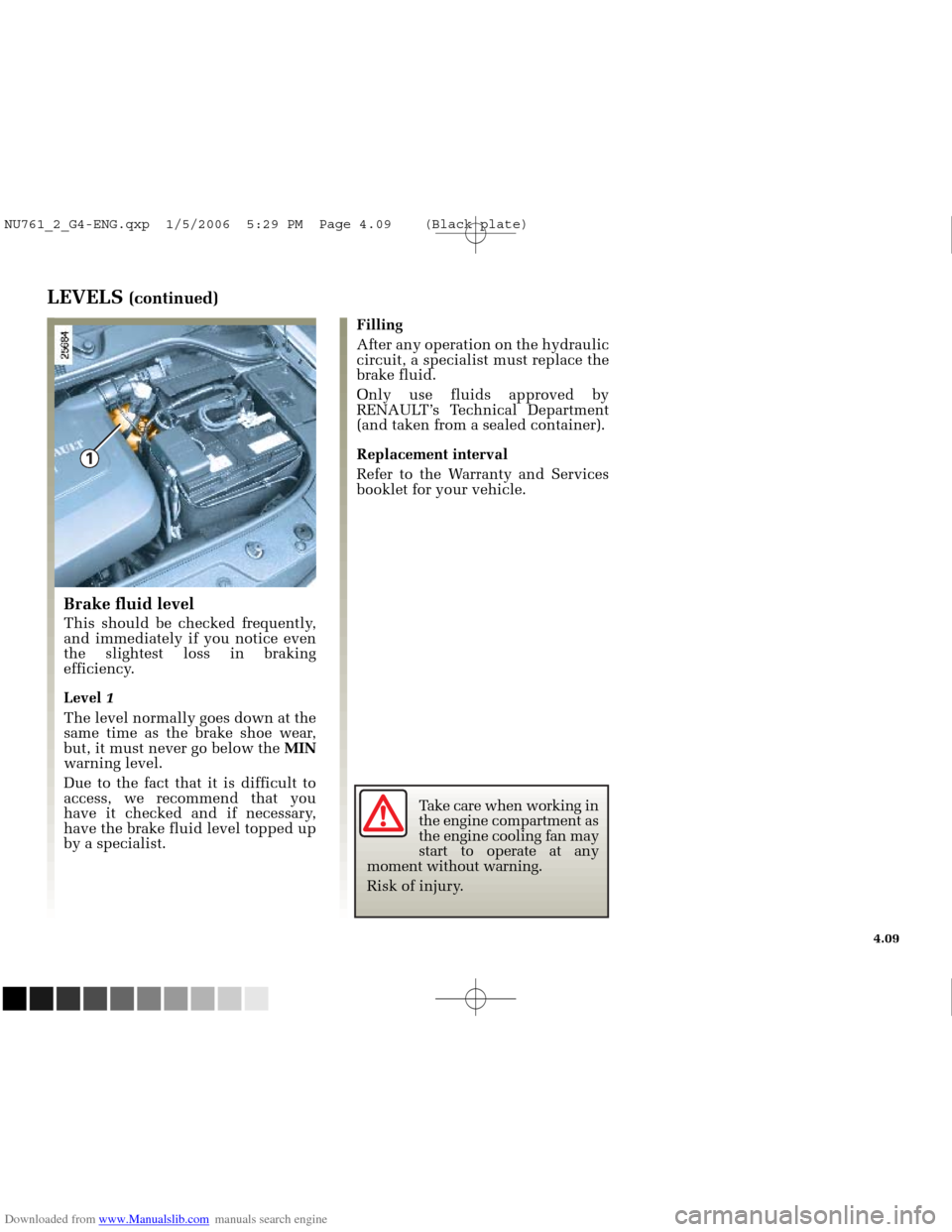
Downloaded from www.Manualslib.com manuals search engine
1
NU761_2_G4-FRA.qxd 14/11/05 10:11 Page 4.09
4.09
LEVELS (continued)
Brake fluid level
This should be checked frequently,
and immediately if you notice even
the slightest loss in braking
efficiency.
Level 1
The level normally goes down at the
same time as the brake shoe wear,
but, it must never go below the MIN
warning level.
Due to the fact that it is difficult to
access, we recommend that you
have it checked and if necessary,
have the brake fluid level topped up
by a specialist. Filling
After any operation on the hydraulic
circuit, a specialist must replace the
brake fluid.
Only use fluids approved by
RENAULT’s Technical Department
(and taken from a sealed container).
Replacement interval
Refer to the Warranty and Services
booklet for your vehicle.
Take care when working in
the engine compartment as
the engine cooling fan may
start to operate at any
moment without warning.
Risk of injury.
NU761_2_G4-ENG.qxp 1/5/2006 5:29 PM Page 4.09 (Black plate)
Page 187 of 250
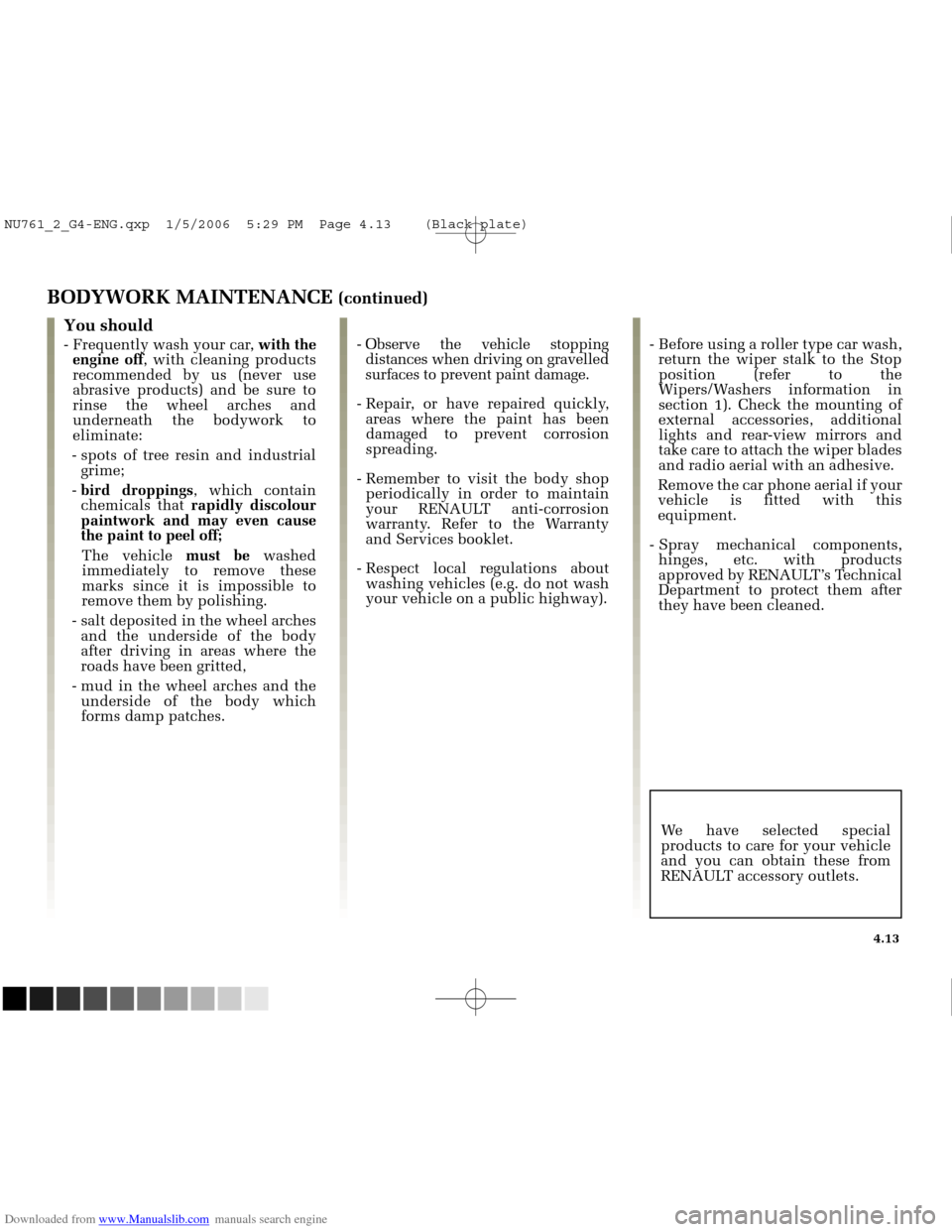
Downloaded from www.Manualslib.com manuals search engine
NU761_2_G4-FRA.qxd 14/11/05 10:11 Page 4.13
4.13
BODYWORK MAINTENANCE (continued)
You should
- Frequently wash your car, with the
engine off , with cleaning products
recommended by us (never use
abrasive products) and be sure to
rinse the wheel arches and
underneath the bodywork to
eliminate:
- spots of tree resin and industrial grime;
- bird droppings , which contain
chemicals that rapidly discolour
paintwork and may even cause
the paint to peel off;
The vehicle must bewashed
immediately to remove these
marks since it is impossible to
remove them by polishing.
- salt deposited in the wheel arches and the underside of the body
after driving in areas where the
roads have been gritted,
- mud in the wheel arches and the underside of the body which
forms damp patches. - Observe the vehicle stopping
distances when driving on gravelled
surfaces to prevent paint damage.
- Repair, or have repaired quickly, areas where the paint has been
damaged to prevent corrosion
spreading.
- Remember to visit the body shop periodically in order to maintain
your RENAULT anti-corrosion
warranty. Refer to the Warranty
and Services booklet.
- Respect local regulations about washing vehicles (e.g. do not wash
your vehicle on a public highway). - Before using a roller type car wash,
return the wiper stalk to the Stop
position (refer to the
Wipers/Washers information in
section 1). Check the mounting of
external accessories, additional
lights and rear-view mirrors and
take care to attach the wiper blades
and radio aerial with an adhesive.
Remove the car phone aerial if your
vehicle is fitted with this
equipment.
- Spray mechanical components, hinges, etc. with products
approved by RENAULT’s Technical
Department to protect them after
they have been cleaned.
We have selected special
products to care for your vehicle
and you can obtain these from
RENAULT accessory outlets.
NU761_2_G4-ENG.qxp 1/5/2006 5:29 PM Page 4.13 (Black plate)
Page 190 of 250
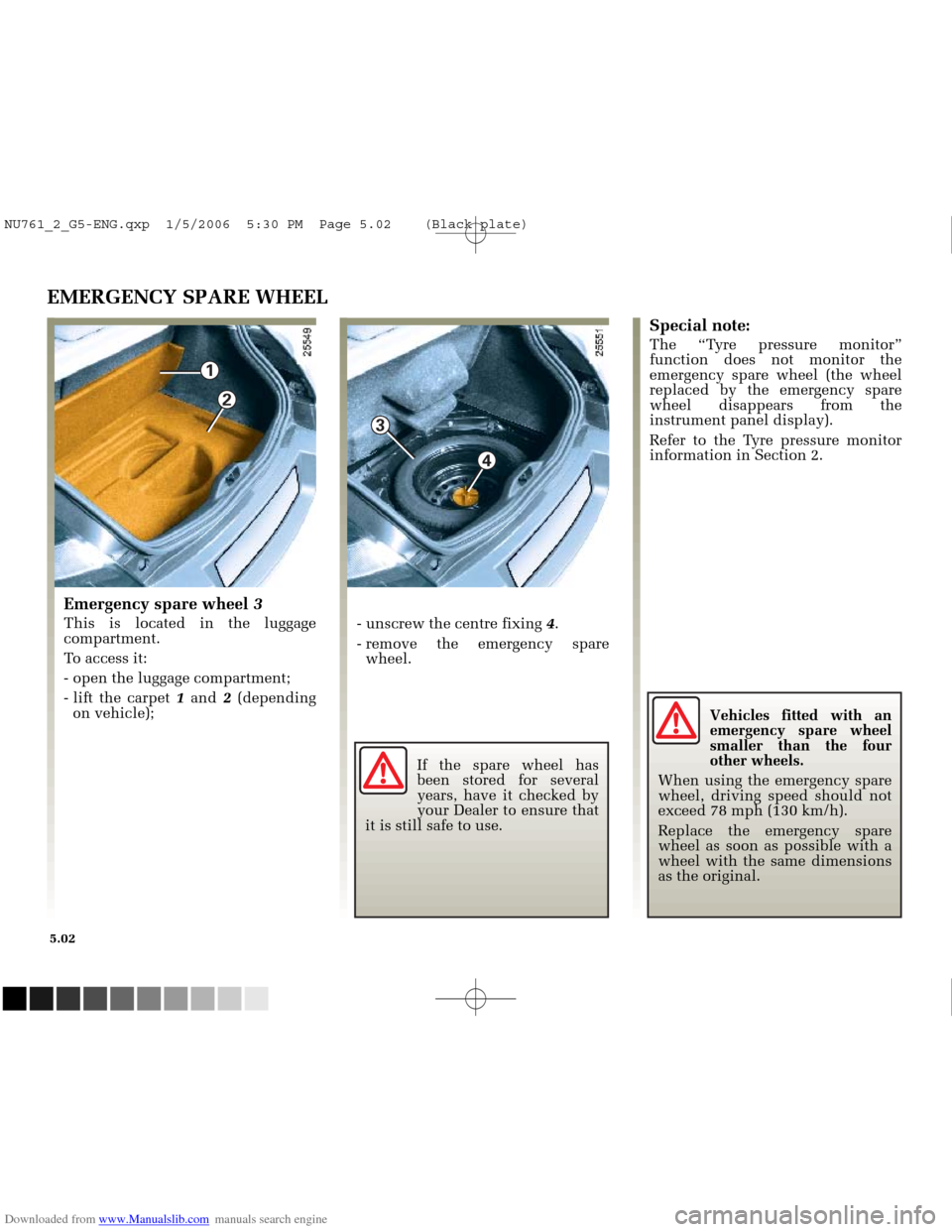
Downloaded from www.Manualslib.com manuals search engine
1
4
3
2
NU761_2_G5-FRA.qxd 4/11/05 11:09 Page 5.02
5.02
EMERGENCY SPARE WHEEL
Emergency spare wheel 3
This is located in the luggage
compartment.
To access it:
- open the luggage compartment;
- lift the carpet 1and 2(depending
on vehicle);
Special note:
The “Tyre pressure monitor”
function does not monitor the
emergency spare wheel (the wheel
replaced by the emergency spare
wheel disappears from the
instrument panel display).
Refer to the Tyre pressure monitor
information in Section 2.
- unscrew the centre fixing 4.
- remove the emergency spare wheel.
If the spare wheel has
been stored for several
years, have it checked by
your Dealer to ensure that
it is still safe to use. Vehicles fitted with an
emergency spare wheel
smaller than the four
other wheels.
When using the emergency spare
wheel, driving speed should not
exceed 78 mph (130 km/h).
Replace the emergency spare
wheel as soon as possible with a
wheel with the same dimensions
as the original.
NU761_2_G5-ENG.qxp 1/5/2006 5:30 PM Page 5.02 (Black plate)
Page 193 of 250
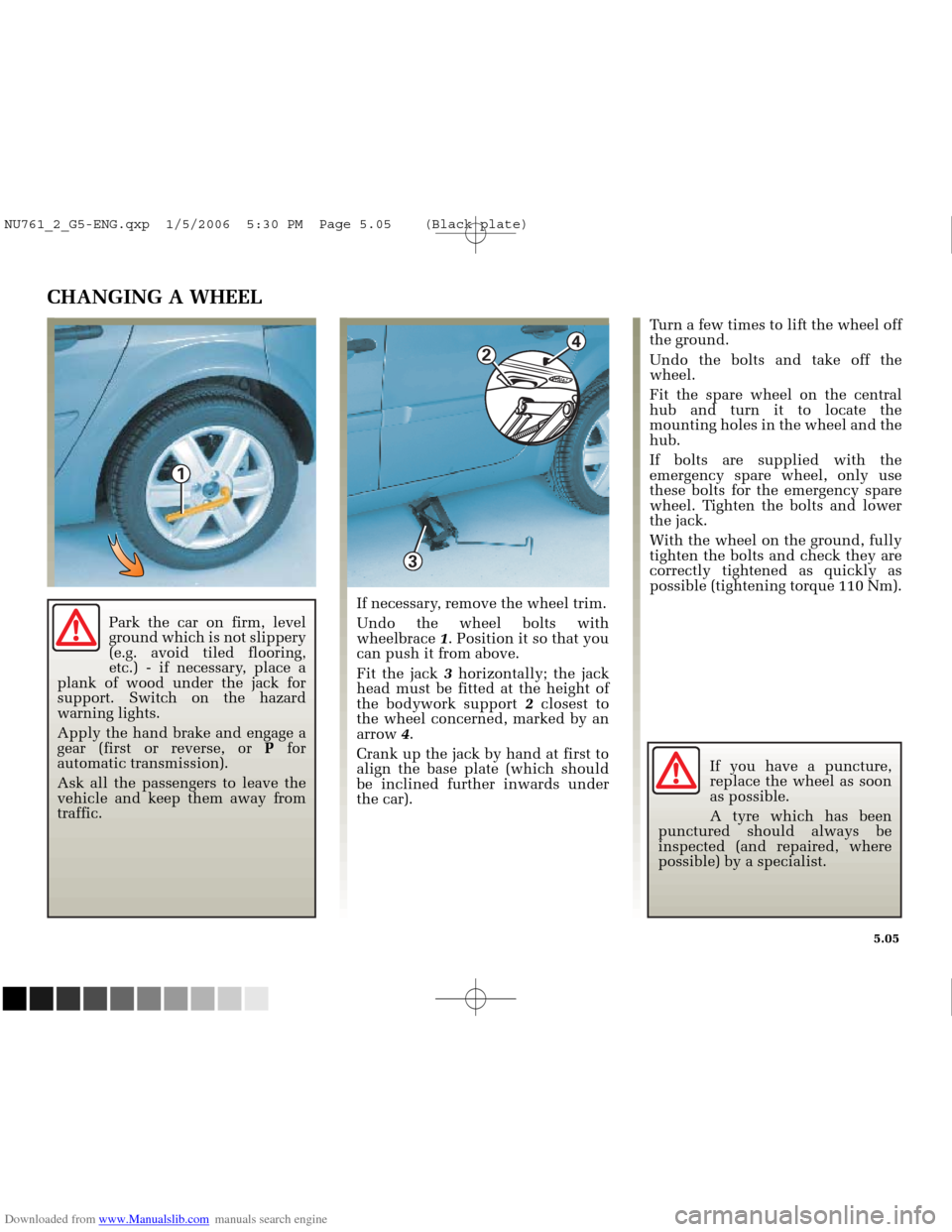
Downloaded from www.Manualslib.com manuals search engine
3
4
2
1
NU761_2_G5-FRA.qxd 4/11/05 11:09 Page 5.05
5.05
CHANGING A WHEEL
If necessary, remove the wheel trim.
Undo the wheel bolts with
wheelbrace 1. Position it so that you
can push it from above.
Fit the jack 3horizontally; the jack
head must be fitted at the height of
the bodywork support 2closest to
the wheel concerned, marked by an
arrow 4.
Crank up the jack by hand at first to
align the base plate (which should
be inclined further inwards under
the car). Turn a few times to lift the wheel off
the ground.
Undo the bolts and take off the
wheel.
Fit the spare wheel on the central
hub and turn it to locate the
mounting holes in the wheel and the
hub.
If bolts are supplied with the
emergency spare wheel, only use
these bolts for the emergency spare
wheel. Tighten the bolts and lower
the jack.
With the wheel on the ground, fully
tighten the bolts and check they are
correctly tightened as quickly as
possible (tightening torque 110 Nm).
If you have a puncture,
replace the wheel as soon
as possible.
A tyre which has been
punctured should always be
inspected (and repaired, where
possible) by a specialist.
Park the car on firm, level
ground which is not slippery
(e.g. avoid tiled flooring,
etc.) - if necessary, place a
plank of wood under the jack for
support. Switch on the hazard
warning lights.
Apply the hand brake and engage a
gear (first or reverse, or Pfor
automatic transmission).
Ask all the passengers to leave the
vehicle and keep them away from
traffic.
NU761_2_G5-ENG.qxp 1/5/2006 5:30 PM Page 5.05 (Black plate)
Page 194 of 250
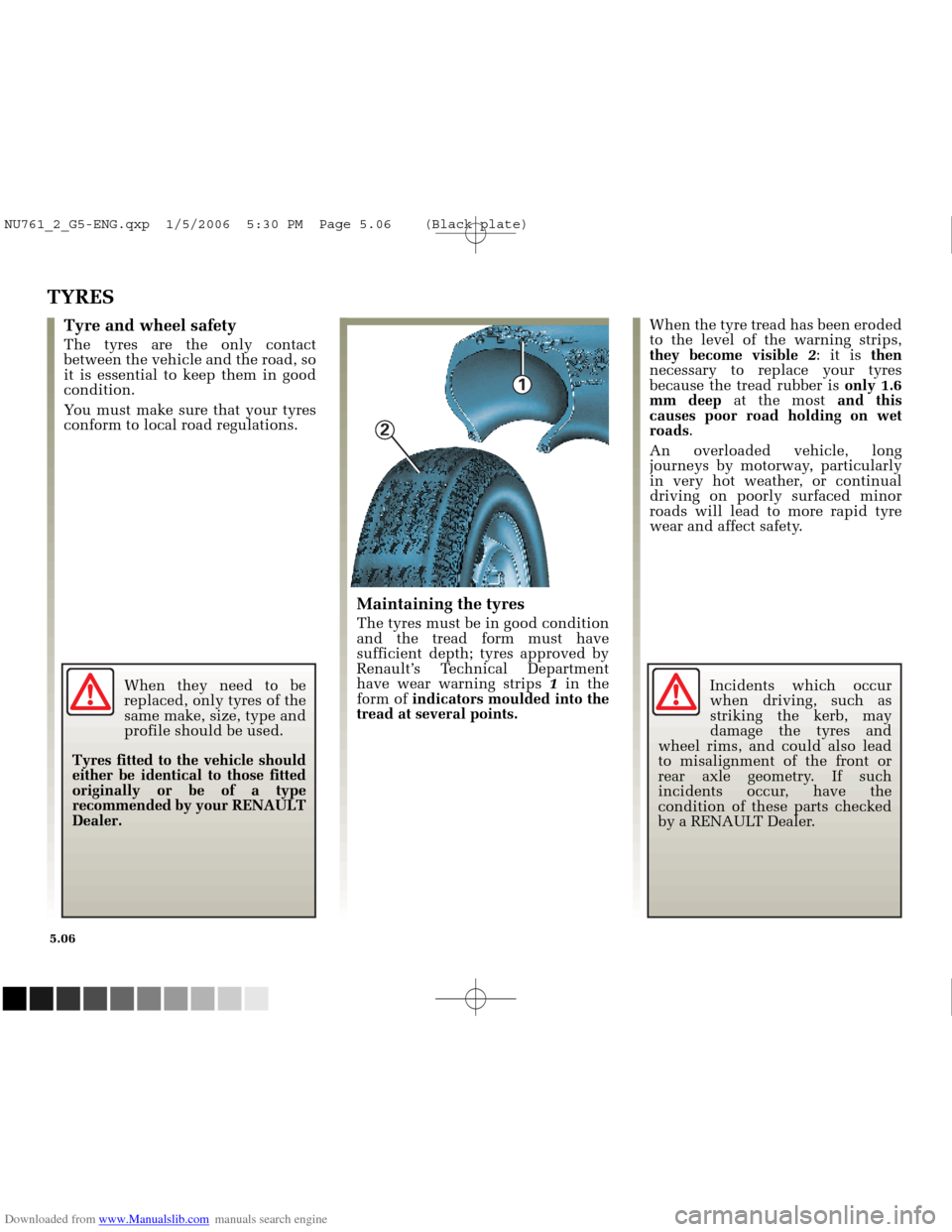
Downloaded from www.Manualslib.com manuals search engine
1
2
NU761_2_G5-FRA.qxd 4/11/05 11:09 Page 5.06
5.06
TYRES
Maintaining the tyres
The tyres must be in good condition
and the tread form must have
sufficient depth; tyres approved by
Renault’s Technical Department
have wear warning strips 1in the
form of indicators moulded into the
tread at several points.
Tyre and wheel safety
The tyres are the only contact
between the vehicle and the road, so
it is essential to keep them in good
condition.
You must make sure that your tyres
conform to local road regulations. When the tyre tread has been eroded
to the level of the warning strips,
they become visible
2: it is then
necessary to replace your tyres
because the tread rubber is only 1.6
mm deep at the most and this
causes poor road holding on wet
roads .
An overloaded vehicle, long
journeys by motorway, particularly
in very hot weather, or continual
driving on poorly surfaced minor
roads will lead to more rapid tyre
wear and affect safety.
When they need to be
replaced, only tyres of the
same make, size, type and
profile should be used.
Tyres fitted to the vehicle should
either be identical to those fitted
originally or be of a type
recommended by your RENAULT
Dealer. Incidents which occur
when driving, such as
striking the kerb, may
damage the tyres and
wheel rims, and could also lead
to misalignment of the front or
rear axle geometry. If such
incidents occur, have the
condition of these parts checked
by a RENAULT Dealer.
NU761_2_G5-ENG.qxp 1/5/2006 5:30 PM Page 5.06 (Black plate)
Page 195 of 250

Downloaded from www.Manualslib.com manuals search engine
NU761_2_G5-FRA.qxd 4/11/05 11:09 Page 5.07
5.07
TYRES (continued)
Pressures should be checked when
the tyres are cold; ignore higher
pressures which may be reached in
hot weather or following a fast
journey.
If the tyre pressures cannot be
checked when the tyres are cold,
assume an increase of 0.2 to 0.3 bar
(or 3 psi. ).
Never deflate a hot tyre.
Note: a label (depending on country
or model) fixed to the edge or frame
of the driver’s door gives the
recommended tyre pressures.
Changing wheels around
This practice is not recommended.
Tyre pressures
Tyre pressures must be adhered to,
tyre pressures for all wheels
(including the spare wheel) must be
checked at least once a month and
always before a long journey (refer
to the information on Tyre
pressures).
Emergency spare wheel
Refer to the information relating to
the emergency spare wheel and
changing a wheel in Section 5.
Fitting new tyres
Incorrect tyre pressures
lead to abnormal tyre
wear and unusually hot
running, factors which
may seriously affect safety and
lead to:
- poor roadholding,
- the risk of blow-outs or of throwing a tread at high speed.
The pressure depends on the load
and the speed of use. Adjust the
pressures according to the
conditions of use (refer to the
information on Tyre pressures). Vehicles equipped with
the tyre pressure monitor
Each of the sensors fitted
in the valves is dedicated
to one particular wheel: the
wheels must therefore not be
swapped around.
There is a risk of incorrect
information which could have
serious consequences. For safety reasons, this
operation must be carried
out by a specialist.
Fitting different tyres may
change your vehicle as follows:
- It may mean that your vehicle no longer conforms to current
regulations.
- It may change the way it handles when cornering.
- It may cause the steering to be heavy.
- It may cause tyre noise.
- It may affect the use of snow chains.
NU761_2_G5-ENG.qxp 1/5/2006 5:30 PM Page 5.07 (Black plate)
Page 206 of 250

Downloaded from www.Manualslib.com manuals search engine
1
3
2
1
2
NU761_2_G5-FRA.qxd 4/11/05 11:09 Page 5.18
5.18
FUSES
Fuse box 1
If electrical equipment does not
work, check the condition of the
fuses.
Open cover 2(underneath the
steering wheel or inside the glove
box).
To identify the fuses, refer to the
fuse allocation sticker (shown on the
following page).
In accordance with local
legislation or as a precautionary
measure:
Obtain an emergency kit of spare
bulbs and fuses from your
RENAULT Dealer.
Take out the fuse using tweezers 3,
located on the cover 2.
To remove the fuse from the
tweezers, slide the fuse to the side.
It is not advisable to use the free fuse
locations.
CORRECT INCORRECT
Check the fuse in question
and, if necessary, replace it
with a fuse of the same
rating.
If you fit a higher-amp fuse, it may
cause the electrical circuit to
overheat (risk of fire) in the event of
a consumer drawing an excessive
current.
NU761_2_G5-ENG.qxp 1/5/2006 5:30 PM Page 5.18 (Black plate)
Page 209 of 250

Downloaded from www.Manualslib.com manuals search engine
NU761_2_G5-FRA.qxd 4/11/05 11:09 Page 5.21
5.21
BATTERY: troubleshooting (continued)
Connecting a battery charger
The battery charger should be
compatible with a battery with a
nominal voltage of 12 Volts.
With the engine switched off, it is
essential to disconnect the cables
connected to both battery terminals,
starting with the negative terminal .
Do not disconnect the battery when
the engine is running. Follow the
manufacturer’s instructions for the
battery charger you are using.
Only a well-charged and well-
maintained battery will have a long
and useful life and enable you to
start the vehicle’s engine normally.
The battery must be kept clean and
dry.
Have the battery’s charge status
checked regularly:
Especially if you use your vehicle for short journeys or for frequent
driving in town. When the external temperature
drops (in winter), the charge
decreases . In winter, only use
electrical equipment which is
really necessary.
Finally, you should understand that the charge decreases naturally
as a result of certain “permanent
electrical consumers” such as the
clock, After-Sales accessories, etc.
When many accessories are fitted to
the vehicle, have them connected
to + after ignition feed . In this case,
it is advisable to have your vehicle
fitted with a battery which has an
increased capacity. Contact your
RENAULT Dealer. If your vehicle is to be left stationary
for a relatively long time, disconnect
the battery or have it recharged
regularly, in particular during cold
weather. The equipment with a
memory, radio etc. will then have to
be reprogrammed. The battery must
be stored in a cool dry place,
protected from frost.
Special procedures may
be required to charge
some batteries. Contact
your RENAULT Dealer.
Avoid all risk of sparks which
may cause an immediate
explosion and charge the battery
in a well-ventilated area. Risk of
serious injury.
NU761_2_G5-ENG.qxp 1/5/2006 5:30 PM Page 5.21 (Black plate)